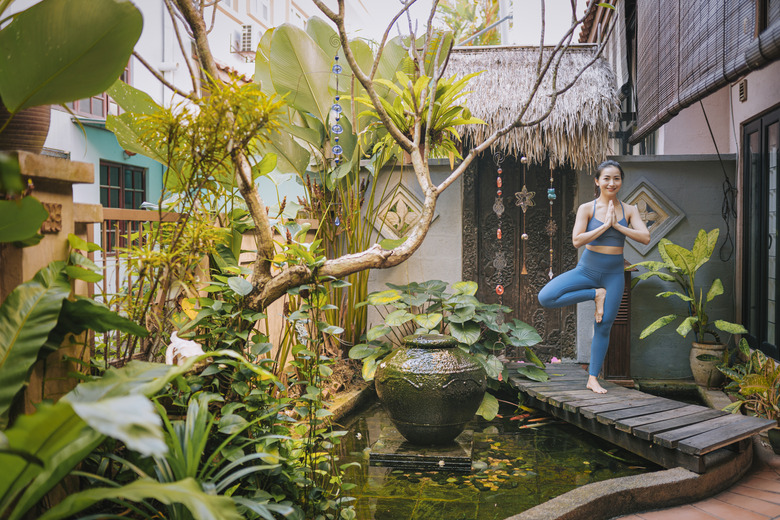How To Care For An Outside Goldfish Pond
While goldfish can thrive in an indoor or outdoor goldfish tank, keeping goldfish in an outdoor pond not only gives the fish more room and freedom to enjoy a happy life but it also adds beauty and interest to your landscape. With the proper setup, taking care of an outdoor goldfish pond is not difficult and requires cleaning the pond, feeding your fish, and ensuring there are beneficial bacteria in the water to keep it clean.
Maintain healthy goldfish
Maintain healthy goldfish
Goldfish are hardy creatures who can thrive outdoors. They can even adapt to survive in colder winter months with proper pond management. When considering goldfish for a koi pond or outdoor goldfish pond, there are many pond goldfish types to consider, and there are different colors of fish to add interest to your pond.
The comet goldfish, for example, has metallic scales and is red or red-orange in color. There is also a hybrid goldfish called the blackout comet that is black in color. Both types of goldfish are 6 to 10 inches long. Other options to consider include the shubunkin goldfish with calico patterns and the red or white wakin goldfish.
Make sure you have a healthy population of fish. Feed your fish once per day with quality fish food that floats on the surface so it doesn't dirty the pond. Keep in mind that the fish will need more food during the warm summer months than during the winter when temperatures cool.
Pond aeration and filtration
Pond aeration and filtration
Keeping the water clean is key to maintaining an outdoor goldfish pond. This is where a good pond design can make your job easier. Make sure the skimmer and filter in your pond are appropriate to handle the size of your pond. These will remove most of the debris from your pond. Empty the skimmer basket at least once per week and consider using a pond net to remove leaves and twigs from the surface of the pond. The biological filter needs to be cleaned every six to nine months.
If there is too much decaying debris in the pond, too much ammonia may accumulate in the water and harm your fish. Treat ammonia buildup with an ammonia neutralizer. Your pond also needs beneficial bacteria to keep the pond water clean and clear so that you can enjoy your fish. You can purchase an autodoser that will handle this automatically or add them manually each week.
Water level considerations
Water level considerations
It is not uncommon for the water level in your pond to drop, especially during dry months. Make sure to add water as needed to maintain a good water level for your goldfish. There are systems that will automatically refill the pond if you prefer not to manage this task manually.
If you use tap water to refill the pond, make sure to treat it with a dechlorinator, as the chlorine found in tap water can be harmful to fish. This is less important if you are only adding a small volume of water.
If you get heavy rain, your pond may overflow. This is less of a concern since you can use a hose or buckets to remove excess water. Check the filters and healthy bacteria after heavy rains to make sure excess plant debris is cleared from the pond. Rain may cause another concern, which is fertilizer runoff into the water. Be sure to follow all instructions and warnings when applying fertilizer to the surrounding landscape.
Other pond care
Other pond care
Plant life in the pond is important for healthy and happy fish and a clean, well-balanced pond. The plants produce oxygen that aerates the water but make sure the plants don't overrun your pond. Algae bloom may also be a cause for concern but is easily treated with an algae buster.
If you live in a hot climate, make sure there is some shade to keep the pond cool. An aerator may be necessary during the hotter months to ensure sufficient oxygen for your goldfish.
Outdoor goldfish pond winter care
Outdoor goldfish pond winter care
Goldfish can survive in an outdoor pond, even over a freezing winter. Stop feeding goldfish when temperatures remain below 50 degrees Fahrenheit. Check the instructions for your filter and skimmer and follow the instructions for winter care. You will likely need to turn them off as temperatures freeze.
A big concern in the winter is when the pond ices over. If the entire pond freezes, it can kill your goldfish, so make sure your pond is large and deep enough so as not to fully freeze in your climate. Before the freeze, clean out as much debris from the pond as possible and remove any plants that can't survive the winter.
Make sure to keep a hole in the ice that is about 12 inches across throughout the winter. This ensures that the goldfish can get sufficient oxygen to survive. Consider using a floating de-icer to keep a portion of the surface clear.
